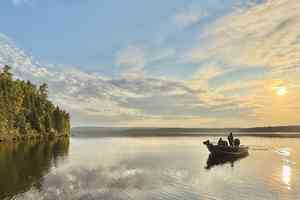Last week the EPA released the results of a study that confirms what anglers, thinking humans and other animals with basic common sense have known all along: what goes on in small streams and wetlands affects the larger streams, rivers and other water bodies they flow into.
Though it may seem nonsensical to suggest that any measure of investigation was necessary to demonstrate what anyone with a rudimentary understanding of gravity would take to be plain fact, the connectivity between headwaters and wetlands and downstream water bodies has been in dispute since a pair of Supreme Court decisions in the early 2000s claimed there was no proven connection between upstream waters and downstream waters, removing protections for small streams and wetlands under the Clean Water Act and making them vulnerable to development.
Since those decisions, anglers and the groups that represent them -- such as Trout Unlimited -- have been fighting to see those protections restored. Partly in response to pressure from anglers and conservation groups, last year the EPA and the Army Corps of Engineers proposed a draft rule that would reduce confusion created by the Supreme Court decisions regarding what kind of water bodies were protected by the Clean Water Act and restore protection to headwaters and wetlands.
The study, Connectivity of Streams and Wetlands to Downstream Waters: A Review and Synthesis of the Scientific Evidence, was commissioned by the EPA in order to help inform the new rulemaking process. The study evaluated findings presented in over 1,200 peer-reviewed, published scientific studies for evidence of how small streams and wetlands connect to larger, downstream water bodies.
According to the EPA, "The scientific literature clearly demonstrates that streams, regardless of their size or frequency of flow, are connected to downstream waters in ways that strongly influence their function." The report also notes that the incremental contributions of individual streams and wetlands are cumulative across entire watersheds.
Trout Unlimited has applauded the report. Steve Moyer, vice president of government affairs for Trout Unlimited stated that, “Today the proposed Waters of the United States rule is on an even stronger footing than it already was. Restoring the protections of the Clean Water Act to headwater streams and wetlands is important to sportsmen and women all across the country, and we look forward to the EPA and Army Corps of Engineers quickly finalizing the rule.”
Helen Neville, Senior Scientist for Trout Unlimited, noted that “From a scientific perspective seasonally flowing streams and headwaters are undoubtedly biologically, chemically and hydrologically connected to downstream waters, but this is old news from an angler’s perspective. We know protecting all of our headwaters provides habitat for spawning and young fish, and provides the high water quality needed for the larger downstream rivers where we all fish.”
Lek Kadeli, the author of the EPA’s report, and the Acting Assistant Administrator in EPA’s Office of Research and Development echoes Trout Unlimited’s unequivocal language, adding that “based on both the extensive, state-of-the-science report and the rigorous peer review process it received, this report makes it clear: What happens in these streams and wetlands has a significant impact on downstream water bodies, including our nation’s largest waterways.”






























Comments